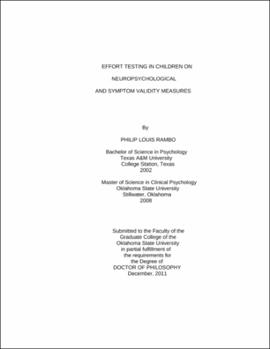| dc.contributor.advisor | Mullins, Larry Lee | |
| dc.contributor.author | Rambo, Philip Louis | |
| dc.date.accessioned | 2013-11-26T08:27:45Z | |
| dc.date.available | 2013-11-26T08:27:45Z | |
| dc.date.issued | 2011-12 | |
| dc.identifier.uri | https://hdl.handle.net/11244/6970 | |
| dc.description.abstract | Scope and Method of Study: Recent efforts have contributed to significant advances in the detection of malingered performances in adults during cognitive testing. However, children's ability to purposefully underperform has received relatively little attention. The purpose of the present investigation was to examine children's performances on some of the more common intellectual and neuropsychological measures, as well as two symptom validity measures: the Test of Memory Malingering (TOMM) and the Dot Counting Test. This was accomplished through the administration of measures to children ages 6-12 in a full effort control condition and a simulated poor effort treatment condition. In addition, prior to randomization, children's general intellectual functioning was estimated via administration of the Kaufman Brief Intellectual Battery, 2nd edition (KBIT-2). | |
| dc.description.abstract | Findings and Conclusions: Univariate analyses revealed that the control group and treatment group differed significantly on some, but not all measures. Also, children's estimated IQ's in the treatment condition significantly differed from the IQ's obtained in the full effort condition and from the full effort IQ's obtained from the treatment children on the KBIT-2, when they were putting forth full effort. These findings suggest that children are fully capable of willfully underperforming during cognitive testing; however, consistent with prior investigations, some measures evidence greater sensitivity in identifying poor effort in younger populations. For instance, WASI Matrix Reasoning and the TOMM were significantly poorer in the treatment condition. In addition, fingertapping also evidenced promise as a test of effort, as both non-dominant tapping and combined tapping performances approached significance in differentiating the two conditions (p <.10). | |
| dc.format | application/pdf | |
| dc.language | en_US | |
| dc.rights | Copyright is held by the author who has granted the Oklahoma State University Library the non-exclusive right to share this material in its institutional repository. Contact Digital Library Services at lib-dls@okstate.edu or 405-744-9161 for the permission policy on the use, reproduction or distribution of this material. | |
| dc.title | Effort testing in children on neuropsychological and symptom validity measures | |
| dc.contributor.committeeMember | Chaney, John M. | |
| dc.contributor.committeeMember | Page, Melanie C. | |
| dc.contributor.committeeMember | Romans, John S. C. | |
| osu.filename | Rambo_okstate_0664D_11704 | |
| osu.accesstype | Open Access | |
| dc.type.genre | Dissertation | |
| dc.type.material | Text | |
| thesis.degree.discipline | Psychology | |
| thesis.degree.grantor | Oklahoma State University | |
